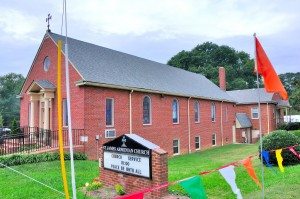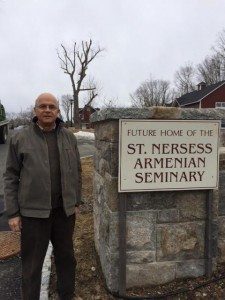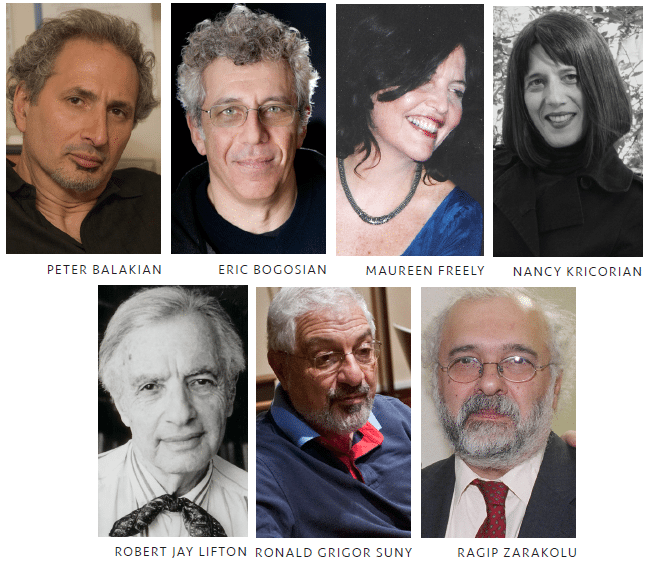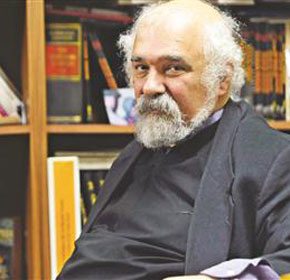Award-Winning Artists, Distinguished Politicians, and Acclaimed Scholars Participate in Impressive Centennial Commemoration
The view could be seen from high above: the bright and shining tricolors of the Armenian flag held proudly by Armenian youth. The traditional music of the Armenian people could be heard reverberating around Times Square: Armenian dancers performing the kochari as 100 white doves glided the air in honor of the Armenian martyrs.
In the face of ongoing denial, the response was loud and clear not only to Turkey but to the world: In the wake of obliteration, the Armenians have only grown stronger, buoyed by a passionate youth, as an unprecedented number of supporters flocked to the heart of Times Square to commemorate the 100th anniversary of the Armenian Genocide on Sun., April 26, 2015.
![]()
A scene from the commemoration (photo: Tom Vartabedian)
More than 15,000 people, including Jews, Greeks, Turks, Assyrians, Cypriots, and Kurds, stood side by side with Armenians to honor the 1.5 million lives lost and to demand justice from the Turkish government for their crimes against humanity.
Although the visible reminder of the Armenian Genocide—the brave survivors—were no longer present in the audience, descendants took their place and carried on their memory through a significant presence and a procession that spanned miles, traveling from St. Vartan Cathedral at 34th St. and 2nd Ave. all the way to Times Square. The exceptional and well-executed event, organized by the Knights and Daughters of Vartan for the past 30 years, once again drew the East Coast to the crossroads of the world and showed the heart and devotion of the Armenian people.
Staunch supporters of Armenian Genocide recognition in the U.S., who appear loyally on stage every April and work behind the scenes throughout the year to bolster the Armenian Republic and diaspora, were in attendance, including Senator Robert Menendez (D-N.J.), who called the Armenian Genocide “one of the darkest events in human history.” He called upon President Barack Obama to formally recognize the Armenian Genocide and said he was disappointed the president had lost his “moral compass.”
![]()
Grammy-nominated artist Sebu Simonian performing in Times Square. (Photo: Anahid Kaprielian)
“We must not make it the policy of the United States to turn our backs on anywhere genocide occurs,” said Menendez, who as chairman of the U.S. Senate Foreign Relations Committee worked tirelessly to pass Resolution 410, demanding that the U.S. acknowledge the Armenian Genocide. “When we do so, we empower those who use genocide as a weapon of war.”
Traveling straight from Armenia where he attended Armenian Genocide commemorations in Yerevan, Congressman Frank Pallone, Jr. (D-N.J.) praised Diasporan Armenians for their accomplishments regarding genocide recognition.
“You have made great progress,” said Pallone, counting the many countries as well as U.S states that have formally recognized the Armenian Genocide.
Pallone reiterated that Turkey must acknowledge the Armenian Genocide and pay reparations. He also noted his support of an independent Nagorno-Karabagh.
“We in the Armenian Caucus will not rest until Congress and the president declare the Armenian Genocide as a genocide.”
Keynote speaker Dr. Stephen Smith, executive director of the USC Shoah Foundation, which is dedicated to making audio-visual interviews with survivors and witnesses of the Holocaust and other genocides, said he stood alongside everyone in the name of memory, peace, humanity, justice, and truth in commemoration of the Armenian Genocide.
“It was no accident of history,” said Smith. “It was designed, it was planned, and it was ordered.”
Smith stated that no one has the power to deny the truth and to control the past. He vowed that the perpetrators will not get away with murder.
“Fact always prevails over falsehood,” said Smith. “If you deny the past, you’re powerless in the present.”
Noting the strength and collective spirit of the Armenian community, Senator Chuck Schumer (D-N.Y.) said, “Empires have risen and fallen, but you’re still here.”
Schumer recalled the founder of the Armenian Genocide Times Square Commemoration, Sam Azadian, who introduced him to the history of the Armenian Genocide when he was a newly elected assemblyman. “In his memory, I am here to fight this fight with you,” said Schumer. “I stand here with you in labeling the atrocities committed against the Armenian people as what it was: genocide. No denier can take that away from you.”
![]()
Senator Chuck Schumer speaking in support of Armenian Genocide recognition. (Photo: Taleen Babayan)
As he took the podium, New York City Council Member Paul Vallone (D-N.Y.) encouraged everyone to chant “Armenia!” Delivering on his promise in previous years to make sure the Armenian Genocide is recognized in the State of New York, the councilman proudly presented the proclamation to the audience and read it aloud for all to hear.
Congresswoman Carolyn Maloney (D-N.Y.) restated her support of the Armenians and refused to let anyone forget the Armenian Genocide.
“The Armenian tragedy is our tragedy,” said Maloney. “We will be with you until it’s in the textbooks of Turkey.
Esteemed Turkish historian and academic Taner Akcam, a trailblazer in openly acknowledging and discussing the Armenian Genocide, said he was representing “another” Turkey, consisting of people who are ready to rediscover their past and to erase the “black stain” on their history.
![]()
Esteemed Turkish historian and academic Taner Akcam addresses the crowd (Photo: Tom Vartabedian)
“I speak for many when I say to the Armenian people my sincere apologies for the past crimes and a century of denial,” said Akcam, to thunderous applause. “I promise in this name of ‘other’ Turkey to put an end to these denials.”
Akcam noted that there is not enough external pressure on Turkey from the international community and it’s troubling that the U.S. continues its denialist policy. He said the Armenian people will receive closure only when the truth is acknowledged.
“Without truth, there cannot be peace,” said Akcam. “On behalf of this other Turkey, we are determined to continue to struggle until truth prevails.”
Academy Award winner and playwright Alex Dinelaris artfully spoke of his grandmother Rose and the influence she had in imbuing his Armenian roots into his life.
“The Armenian culture was in my blood and it nourished me like the food, and it made me realize something I wasn’t before—strong,” said Dinelaris. “I will never forget my grandmother Rose, my ancestors, and the important journeys they made.”
![]()
Best-selling author Chris Bohjalian addresses the crowd (Photo: Tom Vartabedian)
Best-selling author Chris Bohjalian stressed that the genocide matters both morally and politically. He pointed out the direct link between the Armenian Genocide and the ones that followed in the past century, urging the world to “put righteousness before realpolitik.”
“Thanks to our activism we are winning and the denialists are losing,” said Bohjalian. “Let them come again because we will build a new Armenia!”
The musical highlight of the program was a touching performance by popular musician Sebu Simonian of the Grammy-nominated indie pop duo, “Capital Cities.” Traveling from Los Angeles to perform for the Times Square commemoration, Simonian shared his family’s story of escape from the Armenian Genocide before playing his set, which included the poignant Armenian lullaby “Koon Yeghir Balas” (Cradle Song), his personally penned “Cilicia,” and his number one hit, “Safe and Sound.”
Rabbi Steven Burg of the Simon Weisenthal Center, Museum of Tolerance, urged the next generation to continue the fight and stop crimes against humanity. Genocide survivors, including Honore Gatera, Kigali Genocide Memorial Center (Rwanda), and Angelo Maker and Benjamin Machar, the Sudanese Lost Boys Survivors, encouraged everyone to stand hand in hand to build a peaceful world.
Archbishop Oshagan Choloyan, Prelate of Armenian Church of America (Eastern), gave the invocation and Archbishop Khajag Barsamian, Primate of the Diocese of the Armenian Church of America (Eastern), delivered the benediction. Other clergy in attendance included Very Reverend Thomas Garabedian of the Armenian Catholic Eparchy of the United States and Canada.
Knights of Vartan Grand Commander Steve Kradjian and Daughters of Vartan Grand Matron Lisa Kradjian delivered remarks.
Hayg Oshagan, chair of the Armenian Revolutionary Federation (ARF) Eastern Region Central Committee [Editor’s Note: See the full text of Oshagan’s powerful speech here] offered his remarks, as did Van Krikorian, on behalf of the Armenian Assembly of America.
![]()
ARF Eastern Region Central Committee Chair Hayg Oshagan addresses the crowd (Photo: Tom Vartabedian)
The winners of this year’s Knights of Vartan high school essay contest were announced at the program: Davit Hovhannisyan, 1st place, Nicole Ani Issagholian, 2nd place, and Nareg Balian, 3rd place.
The Areni Choir of the Armenian Society of Little Neck, under the direction of Dr. Armine Vardanian, sang the national anthems of the United States and Armenia, as well as “God Bless America.”
The Armenian Radio Hour of New Jersey, led by director Vartan Abdo, streamed the event live in video format worldwide, reaching more than 50,000 people, with the assistance of his dedicated volunteer staff.
![]()
Archbishop Oshagan Choloyan, Prelate of Armenian Church of America (Eastern) and Archbishop Khajag Barsamian, Primate of the Diocese of the Armenian Church of America (Eastern) (Photo: Tom Vartabedian)
The 100th Armenian Genocide Commemoration in Times Square was organized by the Mid-Atlantic chapters of the Knights and Daughters of Vartan and the Armenian Genocide Centennial Committee (Eastern Region). Co-sponsors included the Armenian General Benevolent Union, the Armenian Assembly of America, the Armenian National Committee of America, the ADL-Ramgavars, and the Armenian Council of America. Participating organizations included the Diocese of the Armenian Church of America (Eastern), Prelacy of the Armenian Church, Armenian Missionary Association of America, Armenian Presbyterian Church, the Armenian Evangelical Church, the Armenian Catholic Eparchy for U.S. and Canada and numerous Armenian youth organizations, including the Armenian Church Youth Organization of America, the Armenian Network of America, the Armenian Youth Federation, Homenetmen Scouts, Hamazkayin Cultural Association, Tekeyan Cultural Association, Noyan Tapan of Brooklyn, the Columbia University Armenian Club, the Armenian Students Association, and the People’s Democratic Party Kurdish Delegation, Circassian Society of Greater New York, Greek Hellenic, Pan-Cypriot Group and Assyrian and Syriac Orthodox Groups. Dance groups included Akh’tamar Dance Ensemble NJ, AGBU Antranig Dance Ensemble NY, Aradzani Dance Group NY, Hye Bar Dance Group NY, Vanoush Khanamiryan Dance Academy NY/CT, Hamazkayin Nayiri Dance Ensemble NJ, Hamazkayin Meghry Dance Ensemble, and Yeraz Dance Ensemble NY.
Dr. Mary Papazian, president of Southern Connecticut State University, and Armen McOmber, New Jersey attorney, served as MCs.
![]()
The Homenetmen Scouts taking part in the commemoration (photo: Tom Vartabedian)
![]()
Members of the clergy take part in the march (photo: Tom Vartabedian)
![]()
A scene from the march (photo: Tom Vartabedian)
The post Thousands Gather in Times Square, United in Message, to Honor Armenian Genocide appeared first on Armenian Weekly.
 representing various renowned celebrities, including Whitewater figure Susan McDougal, Chris Brown, “James Bond” movie director Lee Tamahori, talk show host Rickie Lake, actress Gail O’Grady, Congressman Gary Condit, Academy Award-nominated actress Winona Ryder, pop star Michael Jackson, Nicole Ritchie, singer Chris Brown, hip hop stars Nathaniel “Nate Dogg” Hale and Sean “Diddy” Combs (a.k.a. Puff Daddy), international arms dealer Sarkis Soghanalian, and the family of Nataline Sarkisyan, whose 17-year-old daughter died when CIGNA Healthcare refused to authorize a liver transplant.
representing various renowned celebrities, including Whitewater figure Susan McDougal, Chris Brown, “James Bond” movie director Lee Tamahori, talk show host Rickie Lake, actress Gail O’Grady, Congressman Gary Condit, Academy Award-nominated actress Winona Ryder, pop star Michael Jackson, Nicole Ritchie, singer Chris Brown, hip hop stars Nathaniel “Nate Dogg” Hale and Sean “Diddy” Combs (a.k.a. Puff Daddy), international arms dealer Sarkis Soghanalian, and the family of Nataline Sarkisyan, whose 17-year-old daughter died when CIGNA Healthcare refused to authorize a liver transplant.






























